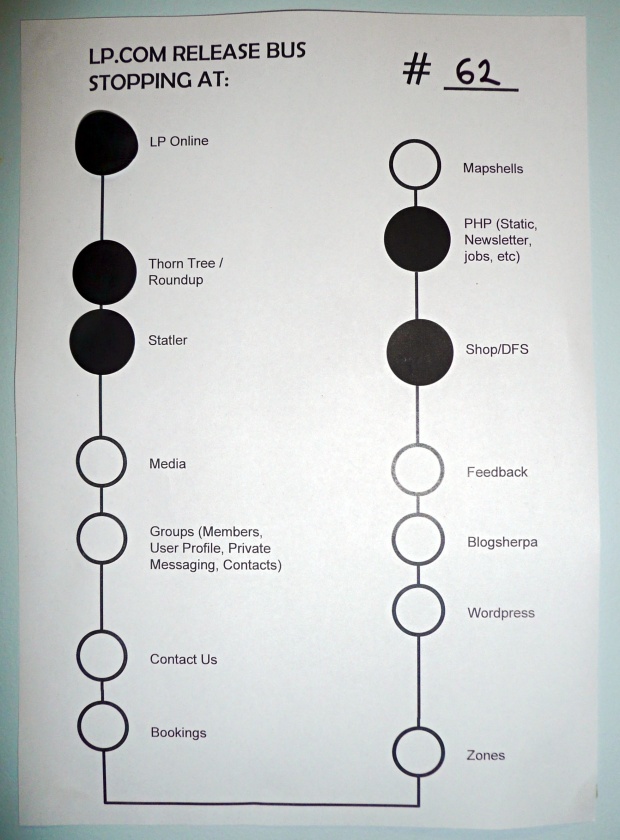Archive for May, 2011
Board Movies
Posted by nthorpe in Lonely Planet SPP Dev Team on May 28, 2011
Dan says: “Just for interest – I thought it would be interesting to see whether any notable patterns came out of it.” – Dan Heath
Sometimes at retro it’s hard to remember everything that went on during the iteration. And sometimes you don’t spot problems at the time they are actually happening. There’s just too much going on.
The brilliant Dan Heath set up a camera with a script which took a photo every 5 minutes and stitched them together as a movie. The team can watch the iteration at retro and can see the cards moving (or not moving) on the wall. Where did they become blocked? Anyone remember why? Who took the last bit of cake?
Dan’s script stitches the images together into a month by month archive of activity on the board, and it only captures images during working hours, so you don’t get hours of spooky darkness.
He was happy to share his scripts. Here are the crontab entries, other scripts are available by email (although Dan warns they were done as a really quick hack job – “the nastiest hack I’ve written since uni”):
# ************* Crontab ***************
# m h dom mon dow command
*/5 8-18 * * mon-fri export DISPLAY=:0 && /home/robh/boardcam/vlc-cmdline/run.sh
1 19 * * mon-fri /home/robh/boardcam/vlc-cmdline/run_daily.sh
Spotted: LPOS development team
If it’s a Release Bus, where does it stop?
Posted by fe in lonelyplanet.com on May 18, 2011
Team Says: “We were sick of the confusion about which apps to deploy each release. Our release manager knew the site backwards but as soon as he wasn’t around it all fell apart”.
The website is a large, complicated beast with many apps to be deployed behind the scenes to provide a single experience for the user. A few times we forgot to release an app with the result that we broke something on the site. Also we needed everyone on the team to be aware of which parts of the system were going to change with each release.
The fix? Since we already had a release bus, we made a bus route map. Every app which runs the site is listed there, and a sticker gets placed over each app that the ‘bus’ needs to stop at during the release. It’s a great visual that provides a checklist to use during the release, and also helps non-technical types understand how complex our website is.
Spotted: lonelyplanet.com website development team
The Dead Card Cemetery – where dead cards go to die
Posted by fe in LP Content Desk on May 10, 2011
Fe says: “That card might get zombied back into the backlog”.
Some cards just never seem to move up the backlog. They are always deprioritised to make way for something else. After a while it becomes apparent that they are never going to get prioritised, that there will always be something more important. But it can be hard to remove a story from the backlog – someone usually still holds that story close to their heart. It’s a good way of managing team members attachment to particular stories. It almost never happens – but if needed, a card can be brought back into play from the cemetery. It’s also a useful visual to show how many things that we think are really important at the time, actually become so unimportant that they never get done.
Spotted: Lonely Planet Content Desk
Countdown to a Milestone
Posted by nthorpe in Lonely Planet SPP Dev Team on May 3, 2011
Team says: “The days are decreasing at exactly one per day, but the feature cards definitely aren’t!”
We’ve seen agile burn-down charts many times. But here’s a different approach. This team runs a lean/kanban board, and they don’t estimate in points, so they decided not to use the traditional burn-down chart. Sometimes, there are immovable deadlines and in this case an author was going on the road to research a destination. Tickets were booked long ago and there was no possibility of delaying the release.
As the release date approached the team simply kept track of the number of feature cards versus the number of days left. This was a nice simple metric which stared them in the face every day, and gave urgency to the task of ruthlessly cutting scope to meet the date. The days always decrease of course, but the card count can increase as additional stories are uncovered. Sometimes product owners can be reluctant to cut scope, but this made it painfully obvious that it was necessary in order to meet the release date. When the number of remaining cards fell below the number of remaining days the back of the beast was finally broken.
Spotted: LPOS Team




